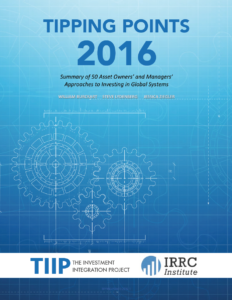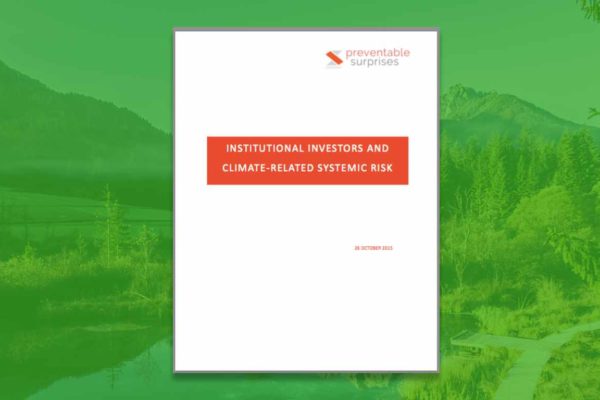 Note: This op-ed was written for Responsible Investor. See the article here.
Note: This op-ed was written for Responsible Investor. See the article here.
Most investment management firms don’t look to the United Nations to provide direction for their strategies. But when the U.N. announced a sustainable development plan to “end poverty, fight inequality and injustice, and tackle climate change,” investors including Sonen Capital, Aviva, PGGM, Triodos Investment Management, and Encourage Capital, started to align themselves. For example, this year, Sonen began reporting on how well its own investments reflect the 17 sustainable development goals described in the U.N.’s 2030 Agenda for Sustainable Development.
The investors believe that the two objectives of making money and solving global challenges are not just compatible, but synergistic.
So do we. In a new report titled “Tipping Points 2016: Summary of 50 Asset Owners’ and Managers’ Approaches to Investing in Global Systems”, we examine a diverse set of investors that have taken practical steps to incorporate global challenges related to the health, food, and energy systems, as well as others, into their daily investing. Key to our findings is that investors have to deliberately incorporate new ways of investing if they want to address big global problems or harness global trends while achieving competitive returns.
In today’s complex environment, it is no longer adequate for investors to think about their investment policies and practices as divorced from the world they live in. Investors have a role in preventing environmental disasters and social unrest, but they can only do so if they think systematically and understand that everything—from the environment to healthcare to the financial markets—is interconnected. To feed, clothe, employ and otherwise provide for a population that will reach 9 billion by the middle of the century, we must develop a financial system that responds to these environmental and societal challenges.
The Principles for Responsible Investment (the United Nations-supported network of over 1,500 investors working to promote a sustainable global financial system), the Bloomberg led Task Force on Climate-related Financial Disclosures, and The Global Impact Investing Network’s (GIIN) campaign urging investors around the world to “channel their capital to impact investing” are just a few of the major industry initiatives aimed at helping investors to see the bigger picture that is emerging.
But many challenges remain. It’s difficult to quantify how one investment in a renewable energy company in Seattle, for example, contributes to the global goal of reducing climate change articulated by the U.N. And there’s still a lack of familiarity with this idea of investing with intentionality. We must educate staff, clients and other key stakeholders on the nature and materiality of systemic considerations.
To overcome these barriers we need a broader understanding of our ability to shape the future. The sophisticated techniques developed in the latter half of the 20th century for managing portfolio-level risks and rewards do their job well. What we need now, though, is a more comprehensive understanding of the impact of these investments on the environment and society — of the feedback loops between investment practice and the environmental, societal and financial systems that are the framework within which investment operates.
As our research shows, in taking this next evolutionary step asset owners and managers have begun to establish a parallel set of policies and practices alongside their traditional approach to investing at a portfolio level. They are incorporating policies and practices into a number of basic investment activities—belief statements, security selection, engagement, targeted investments and manager selection—that intentionally confront systems-level challenges, such as maintaining a sustainable environment and a stable social structure, and that manage their impacts at these levels.
We found that a key ingredient in successful investments of this kind—which we call systems-level investing—is intentionality. That means intentionally taking steps to impact global systems. We identified ten types of intentionality: solutions, additionality, diversity of approach, evaluation, geographic locality, interconnectedness, polity, self-organization, standards setting, and utility.
Investors use these tools intentionally because modern portfolio theory alone does not naturally lead them to do so. For example, PGGM, the Dutch pension fund manager, has allocated a multi-billion dollar portion of its assets to what it describes as a “solutions” portfolio that focuses on four issues: climate change, food, healthcare and water. In this way PGGM is intentionally creating investment vehicles that can achieve competitive returns while targeting particular social or environmental problems of substantial systems-related importance. One of the goals of a solutions-focused approach is to address challenges confronted by fundamental elements of social and environmental systems broadly conceived.
Other investors intentionally seek out sound investments that support and strengthen interrelated economic activities within a geographic region. The Ireland Strategic Investment Fund by mandate invests in enterprises “in a manner designed to support economic activity and employment in Ireland.” Similarly, to contribute to the vitality of Montreal, the regionally focused Caisse de dépôt de Québec has invested in a combination of public transportation and downtown office buildings and hotels.
Others are intentionally pursuing investments that address issues historically underserved by mainstream finance: a practice known as additionality. These firms choose investments that strengthen often neglected elements of overarching systems – elements that add to these systems’ stock of resources, increase their complexity and thereby provide them with additional resilience. This means investing in improved opportunities for broad access to financial services, technology, healthcare or energy for those who have been historically underserved.
The implication of these individual efforts—and the ten tools of intentionality more generally—is that investors are increasingly managing two goals simultaneously: positive social impacts and making money. On the one hand, investors—buying and selling in the marketplace daily—manage their portfolios on the basis of price, seeking to maximize their returns while minimizing their risks. At the same time, these investors—with an eye to the long-term preservation and enhancement of the frameworks within which they operate—are seeking to manage their impacts at the environmental, societal and financial systems levels. By integrating both goals, they work to achieve a balance between doing good and making profits, between values and price, between reason and rationality. In doing so in this complex world of the 21st century, they seek to enhance value at the systems level without contributing to its destruction.
These intentional steps toward positive impacts at systems levels may still be hesitant, may be taken by relatively few, may be unclear yet as to their effectiveness, and may lack consistent articulation. But, they are an important part of the evolution that finance appears to be taking as it contends with the realities of volatile financial markets, staggering social need and increasing environmental instability.



